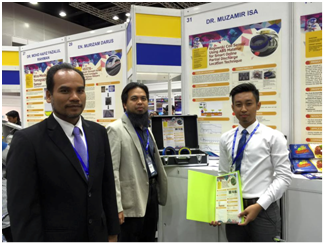- Category: PENYELIDIKAN SLIDER
- Written by Sharifah Noor Sahila Syed Jamal
Rogowski Coil Sensor using ABS Material for Smart Online Partial Discharge Location Technique
|
|
|
|
|
|
|
In high voltage (HV) engineering, partial discharge (PD) is an electrical discharge or spark that bridges a small portion of the insulation. PD resembles a cancer in the insulated cable before the fault happens. The conventional technique experience severe limitation when it comes to on-line monitoring due to the influence of background noise that distort the pure PD signal, absence of non-intrusive sensors and processing facilities. Moreover, the limit in the detection of frequency range PD especially in HV cables due to the attenuation of high frequency PD signal. Low detection in term of sensitivity and frequency for the sensor are fundamental limitation the PD detection which the major concern in insulation monitoring. The PD sensor must be installed in existing network during operation and may not risk of failure for the power grid. High frequency current transformer (HFCT) has traditionally been used well for this measurement because of its additional ability to produce higher outputs needed by electromechanical equipment. The problems like saturation, size, weight and high cost are some factors which limits its use if frequent monitoring is required. Moreover frequency response to PD signals by sensors is important are to be improved. Research on an incoming non-conventional current sensor which is coreless inductive sensor has raised great interest. This project is a new design of Rogowski coil (RC) sensor as a cost effective and efficient (high sensitivity and wide bandwidth) for PD detection in medium voltage (MV) line. The design of RC sensor using Marker Bot Replicator 2X 3D printer using Acrylonitrile Butadiene Styrene (ABS) filament makes the design of PD sensor more accurate in term of geometry. The ABS material is selected based on its characteristic to provides more robust, durable, lightweight, withstand to high temperatures and accurate geometry to the sensor. It is preferred plastic for engineering product in professional application.
Various types of virtual surgical instruments are available in the simulator for users to choose when performing particular surgical procedures. Since two haptic devices are equipped for the surgical simulators, surgeons and medical trainees are able to switch the tools between both hands by referring to the graphical user interface (GUI) that is created in the platform. Visual feedback such as tissue deformation and force reaction movements of human eyeball are implemented into the simulator along with haptic feedback that gives tactile sensation when collision is detected during the simulation. Users are able to sharpen their skills on specific surgical procedures by referring to the performance evaluation system embedded in the simulator. Concerns in phacoemulsification cataract surgery such as position of corneal incision and damage on posterior capsule during phacoemulsification are embedded in the proposed surgical simulator to improve the awareness of ophthalmologists in avoiding surgical trauma and retinal detachment. Besides that, graphical surgical guidance and evaluation in the simulator are able to assist ophthalmologists along their surgical training. |
|
Keywords: Partial discharge, High Voltage Insulation, Medium Voltage Distribution Lines, Sensors, Smart Online Partial Discharge Location Technique. |
|
|
|




